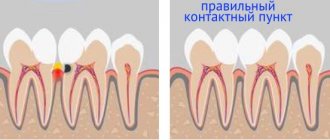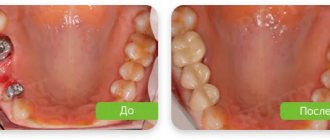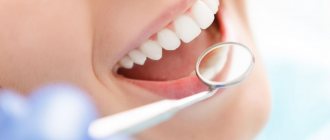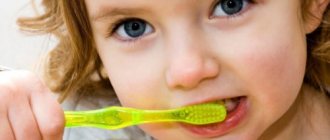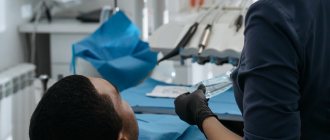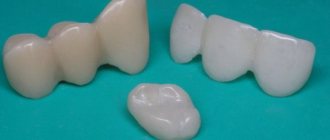The presence of milk teeth in adults cannot be attributed to the realm of fantasy or humor. This phenomenon can sometimes be encountered in dental practice. What contributes to the fact that a baby tooth can be preserved in adults and what to do with such a childhood “relic”?
Echo of childhood
Most people believe that baby teeth are closely associated with a touching and carefree childhood. It’s not for nothing that James Barry, a Scottish writer, in his fairy tale about Peter Pan - a boy who wants to always be young and not grow up - specifically describes that there were many milk pearl teeth in his mouth, and none of them had fallen out yet. Replacing baby teeth with permanent ones can be considered the same step into adulthood as the first room at school and the first two.
Teeth begin to change at about 5-6 years of age, and this process ends at about 12-14 years. Currently, according to the observations of many doctors, the replacement of baby teeth with permanent ones occurs in younger children than happened in past decades. But it also happens that baby teeth can be preserved in adults. Such cases can be encountered at 20, 30, and sometimes at 50 years of age. Why does this happen and what to do in such a situation?
Milk teeth and their features
Temporary and permanent teeth have certain differences in structure. The shape of baby teeth is the same as in molars (permanent), but their size is much smaller, the roots are shorter, and the number is different - there are only 20 of them versus 32 permanent teeth (including wisdom teeth). “Children’s” teeth are characterized by a short service life: their roots dissolve over time (as dentists say, “resorb”) approximately 2-3 years after they are fully formed. This process begins with the area touched by the crowns of the permanent teeth growing underneath them.
But it happens that for one reason or another the formation of the rudiments of permanent teeth does not occur. In this case, the roots of baby teeth are more often resorbed as a result of the influence of the rudiments of permanent adjacent teeth. But it happens that this does not happen and “children’s” teeth can then remain in adults - dentists call them persistent (translated from Latin persistere - to remain, to remain).
With or without fluoride?
Nowadays there is a lot of talk about the dangers of toothpastes with fluoride. Allegedly, they can harm dental health. On the other hand, it is believed that fluoride-containing pastes are the best prevention of caries. Where is the truth?
Nina, Mytishchi
– Fluoride is really necessary for dental health, because it makes the enamel more resistant to various acids, and therefore protects teeth from caries. However, its excess can lead to another dental disease - fluorosis, which, like caries, leads to the destruction of tooth enamel. Fluoride mainly enters the body through water or food. But the fluoride content in toothpastes is not too high, and the duration of exposure of the toothpaste to the enamel during brushing is completely minimal. Therefore, pastes cannot cause fluorosis, but they are also unable to effectively protect teeth from caries. Although most studies show that the use of fluoride-containing toothpastes to a certain extent reduces the incidence of caries. Therefore, whether to buy toothpaste with fluoride or not is a personal choice.
Why may there be no rudiments of permanent teeth?
There are a variety of reasons that contribute to the absence of permanent tooth buds. These include hereditary characteristics, osteomyelitis of the jaws and their traumatic lesions, metabolic disorders, pathology of the endocrine glands. In addition, acute and chronic inflammation of baby teeth, in particular, untreated periodontitis in a timely manner, can also damage the rudiments of permanent teeth and contribute to their death.
Sometimes it happens that the rudiments of permanent teeth are formed, but can lie quite deep without touching the roots of milk teeth. This may occur due to the incorrect position of the permanent tooth or lack of space. In such cases, baby teeth can also be found in adults.
Age is not a barrier
I am 65 years old. The doctor suggests installing implants. Is this harmful at my age?
Alexey Petrovich, Balashikha
– In the middle of the last century, when dental implantation was just becoming part of widespread dental practice, contraindications to the installation of implants were quite strict. They were not installed in elderly people, patients with diabetes mellitus, or autoimmune diseases. But with the current level of medical technology, implants can be recommended to almost all patients at any age. By the way, there are no restrictions on the number of implants installed at a time. The only danger associated with this procedure is the use of general anesthesia, which can pose health risks.
However, you need to understand that the lifespan of an implant depends on your oral hygiene. If it is insufficient, it can lead to gum disease and loss of the implant.
Treat without a drill. What procedures have dentists refused? More details
Do adults need to have their baby teeth removed?
Undoubtedly, baby teeth can often cause problems in adults. Firstly, their service life is short, which is why their resistance to caries is much lower compared to permanent ones. Secondly, teeth that do not fall out on time can interfere with the growth of permanent teeth and also cause them to be incorrectly positioned. But this does not mean that if a baby tooth is found in an adult, it must be removed. Everything is individual and depends on the specific situation. Very often, it is recommended to leave baby teeth in adults that are well preserved so that they last as long as they can. After all, sometimes it happens that permanent teeth may never appear in their place.
In any case, what to do with a baby tooth in adults needs to be decided after an X-ray examination is carried out, which will help determine the presence or absence of the rudiments of an unerupted permanent tooth, as well as whether the process of resorption of the baby tooth root is ongoing. If the rudiments are not found and the roots of a baby tooth have not been reabsorbed, and it looks aesthetically pleasing and immobile, then such a baby tooth should not be removed. The same applies to cases where it is X-ray proven that the position of the permanent tooth is such that even after removing the milk tooth, it will not be able to erupt. However, in this case it is better to consult an orthodontist.
Treatment
At an early age, treatment is aimed at actively stimulating proper growth and formation of teeth, as well as diagnosing and preventing their deformation.
Once the main 7 permanent teeth have erupted, you can begin to think about replacing missing ones. In most cases, such treatment is preceded by special preparation carried out by the orthodontist, and then subsequent procedures to restore the missing tooth.
Treatment methods:
- Dental prosthetics using metal-plastic or zirconium oxide-based crowns;
- Adhesive bridge;
- Dental implantation;
For example, with symmetrical defects (no fangs), the doctor may suggest moving the nearest teeth in place of the missing ones to replace them. It is possible to transform nearby teeth (premolars) into fangs by applying a special photopolymer-based material to them. But, in the field of dental treatment, this is aerobatics, which is not accessible to everyone. And now we are not talking about the financial situation, you also need to find an experienced doctor, namely a restorative orthodontist.
Removable prosthetics and implants will help in the fight against edentia
In case of complete secondary adentia (when teeth are completely missing), treatment methods can only be removable prosthetics or, in some cases, installation of implants. Partial secondary adentia can be treated by so-called “ orthodontic preparation ”, in simple terms - prosthetics.
What to do if a baby tooth can cause problems?
If you are not satisfied with the aesthetics of a baby tooth or it is mobile, you still need to start with an x-ray examination. Having discovered on an x-ray that there are no rudiments of a permanent tooth, and the roots of a baby tooth have been reabsorbed, and mobility of the 3rd - 4th degree is observed (the tooth is very mobile), then it needs to be removed and then a decision must be made about what type of prosthetics to use in this case. case.
If you are not satisfied with the appearance of the tooth, you also need to use an x-ray to determine the condition of the roots of the baby tooth and the rudiments of the permanent tooth. Further, the decision must be made individually in a specific case. It depends on the age of the patient, as well as on the place of the baby tooth in the dentition. If there are no rudiments and the roots of a baby tooth are present, a veneer can be installed on it or the tooth can be restored, making it invisible in the dentition. Those who want to completely transform their smile will benefit from Lumineers.
If there are rudiments of a permanent tooth, you need to estimate how long it will take before erupting and decide to remove the baby tooth and pull out the permanent one.
Although the presence of baby teeth in adults can be considered an anomaly, this is not a reason to part with them - after all, very often they can serve you for many years. But sometimes it happens that such “greetings from childhood” can become an obstacle to the eruption of a permanent tooth. Therefore, if you discover that you have a baby tooth, be sure to take an x-ray and consult a specialist.
Save forever
How to properly take care of your dental health in order to preserve them until old age?
Olga, Moscow
– The main principle of maintaining dental health is compliance with primary prevention measures, which can be divided into three types – state, family and personal. If we talk about the state prevention system, today people are more concerned not about the availability of dental care, but about its cost. The problem is partly solved by the Compulsory Health Insurance Fund, which covers the costs of emergency dental care (treatment of caries, pulpitis and much more).
Family prevention is, first of all, traditions that are observed in everyday life. If parents are accustomed to taking care of their teeth and regularly attend preventive dental examinations, then their child will definitely learn this behavior model in the future. As for personal prevention, it includes proper nutrition and a high level of oral hygiene. And here you can’t do without regular examinations with a doctor, who will not only professionally remove plaque, but also give individual recommendations on the selection of hygiene products.
Dental health also depends on diet. For example, products containing coarse fiber (fresh vegetables, fruits) act as a natural toothbrush that effectively cleans plaque. In addition, vitamin C is necessary for dental health. It is responsible for the condition of the tissues surrounding the tooth, and most cases of tooth loss are associated with gum disease.
"Forbidden." 10 foods that are enemies of tooth enamel Read more
Consumer Reviews
Valera (otzyvru.com)
“The dentist recommended the Asepta vitamin and mineral complex for teeth, since the condition of my oral cavity is not the best: my gums are bleeding, my teeth are already beginning to crumble at the age of 30. I started taking these vitamins, not forgetting about other hygiene. I completed the course in two weeks, and my teeth are stronger.”
MigulkaM (irecommend.ru)
“Unfortunately, nature works in such a way that the baby takes all the substances it needs from the mother’s body. It seems like I ate more than one kilogram of cottage cheese during pregnancy, and took special vitamins, but still, after giving birth and breastfeeding, I started having terrible problems with my teeth. Firstly, the caries is already enough - literally once a month there is a new hole. But most of all I was tormented by my gums - they constantly hurt, are red, and bleed.
My doctor said that I couldn’t manage with pastes and gels alone, the problem was most likely a deficiency of vitamins, and along with Asepta toothpaste, she recommended their Asepta vitamin and mineral complex to me. He says that he has been prescribing it to his patients for several years now. What I immediately liked about these vitamins is that you have to take them once a day - I definitely won’t forget. In the third week of taking it, I noticed clear improvements in my gums - they stopped hurting and bleeding when brushing.
I took the full course - 6 weeks, I can’t say about caries yet - just the day before I filled all the holes, but I got an unexpected bonus from these vitamins - my hair became much more vibrant, shiny, and my nails stopped peeling - apparently, not only for my teeth there weren’t enough vitamins and minerals.”
Sources:
- The effectiveness of complex therapy in the treatment of periodontal diseases. (Department of Periodontology of the SF State Budgetary Educational Institution of Higher Professional Education MGMSUIM.A.I. Evdokimova. Moscow.) Nemeryuk D.A. - Associate Professor, Candidate of Medical Sciences, Dikinova B.S. - Postgraduate Student of the Department of Periodontology of the SF Tsargasova M.O. - Postgraduate Student of the Department periodontology SF Yashkova V.V. - postgraduate student of the Department of Periodontology of the SF Department of Periodontology of the SF State Budgetary Educational Institution of Higher Professional Education MGMSUIM.A.I.Evdokimova. Moscow
- The effectiveness of the use of Asepta balm in the treatment of patients with inflammatory periodontal diseases (Doctor of Medical Sciences, Professor Elovikova T.M., Department of Therapeutic Dentistry, USMU. Yekaterinburg) Doctor of Medical Sciences, Professor Elovikova T.M. Department of Therapeutic Dentistry, USMU. Ekaterinburg
- The role of hygiene products in the treatment of periodontal diseases (S.B. Ulitovsky Honored Doctor of the Russian Federation, Honored Dentist StAR Prof., Doctor of Medical Sciences, Department of Preventive Dentistry of Pavlov Pavlov State Medical University, St. Petersburg) S.B. Ulitovsky - Honored Doctor of the Russian Federation, Honored Dentist of StAR, Prof., Doctor of Medical Sciences; E.S. Alekseeva - associate professor, candidate of medical sciences; A.A. Vasyanina - associate professor, candidate of medical sciences; V.A. Grigoriev - Associate Professor, Ph.D.
Clinical researches
The effectiveness of Asepta products has been proven by numerous clinical studies. For example, according to the results of tests conducted at the Department of Periodontology of the SF State Budgetary Educational Institution of Higher Professional Education MGMSUIM.A.I. Evdokimov in Moscow, the high effectiveness of including Asept dosage forms in the complex therapy of inflammatory periodontal diseases was proven.
In the process of complex treatment of periodontal disease using Asept dosage forms, patients showed an improvement in both subjective and objective manifestations of the disease.
How tooth loss affects facial contours
Loss of teeth, especially complete ones, immediately affects a person’s appearance. Firstly, the height of the lower third of the face decreases due to the fact that the support of the lower jaw by the teeth is lost and the jaw moves back in the joint area, and forward and upward in the chin area.
The result is a so-called “senile face” - the distance between the tip of the nose and the top of the chin decreases. Due to this, the natural folds of the face deepen, the corners of the mouth droop, the red border of the lips decreases in width due to their displacement towards the oral cavity.
Losing teeth causes a decrease in the tone of facial muscles, the cheeks and chin tissues sag. Visually, the face looks more mature. Dental restoration sets the lower jaw in the correct position, provides support to soft tissues, and restores the smile. As a result, facial rejuvenation occurs, patients feel confident, and their quality of life improves significantly.
These changes are also possible with partial loss of teeth.
Especially in the case of chewing teeth. I have patients (women) who turned to a cosmetologist with a desire to improve their facial contours and eliminate sagging cheeks. In response to this, the doctor strongly recommends that the missing chewing teeth be restored first to provide soft tissue support and only then begins his own procedures. Because only in this case we get the most complete and long-lasting effect.
Is Amalgam Safe?
I have an old amalgam filling in my mouth. They say that such fillings can release mercury and lead to poisoning. Maybe it's worth changing the filling?
Tatiana, Odintsovo
– In the 90s of the last century, the dental community adopted a convention on amalgam fillings. Within the framework of this convention, amalgam fillings have been practically not used in the Russian Federation for 20 years. However, this is not due to the danger of such fillings for human health, but to the environmental problems that can arise during the production of mercury. Replacing amalgam fillings should happen organically, with clear indications, and not because they are dangerous to the human body.
Why do wisdom teeth grow - are they necessary?
Wisdom teeth today are considered a vestige, that is, an echo of the past, unnecessary or with an unclear function, like appendicitis. Ancient people needed 32 teeth, since the food was hard and rough. But gradually the human diet changed, and modern food does not require such hard and long chewing. This led to a shortening of the jaw and a decrease in the space where the eighth teeth should be located.
Today, wisdom teeth cause more inconvenience than they bring benefit. Their appearance is often accompanied by pain during teething and impaired jaw mobility. They are more susceptible to caries than other teeth, which is why in most cases they have to be removed. At the same time, there is also a danger of damage to important nerves and blood vessels during removal.
Many people mistakenly believe that “eights” can become a reliable base for a bridge. However, these teeth are not suitable as a support for any, even the lightest structures.
